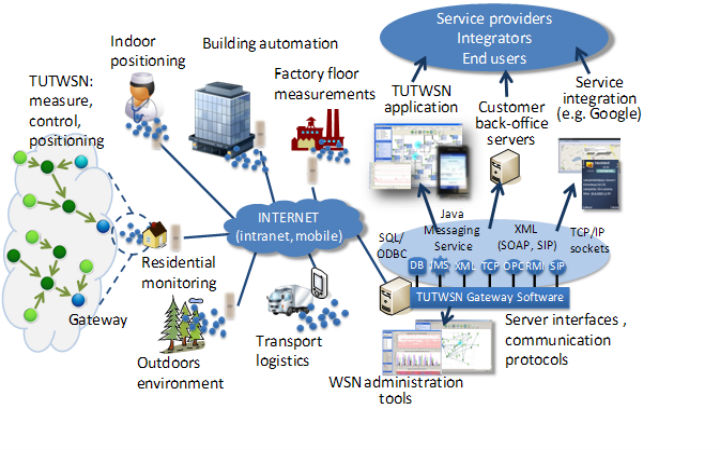Wireless Sensor Network Thesis.
Wireless sensor network thesis is processed by researchers where variety of fields as optical, chemical, mechanical, magnetic sensors and thermal are attached to sensor node for calculating environment properties. Tiny, autonomous device group are worked to solve problems in wireless sensor network. Two types of protocols are used in wireless sensor network to carry out communication among nodes to transfer collected data to sink.Thesis on wireless sensor networks contrasts different simulators to calculate useful simulator in various applications for transmission purpose. A communication process with sensor devices for transmission, controlling devices and measuring certain units is wireless sensor network. As a resource constrained network function WSN act and where it is not only a database. WSN environment is data centric and event driven. WSN is as same as real time, database and embedded systems. On area of interest and environment size WSN is based.
Simulators for Wireless Sensor Network Thesis.
World sens: Various simulators as Wsim and WSNet are contained in world sens. An event driven simulator is WS Net and in C++ language it is written for large-scale WSN it provides simulation for hardware platform with micro controller codes Wsim supports simulation.
Cooja: For operating system contiki cooja is the simulator that is used. In C contiki applications are coded and written in java.
ShoX: In java ShoX is written and they are designed for wireless sensor network and it supports GUI to create different networks.
TOSSIM: For application coded in nes C language TOSSIM is used. It acts as a simulator of tiny operating system. In phython or c++ the simulations are written.
OMNET++: Component based simulator is OMNET++ and used for wireless and wired network simulations. In C++ the components are developed. When compared to NS2 it is more generic modular architecture with rich library platform is provided in OMNET++.
Opnet: Commercial software is opnet and used to study simulation of wireless sensor network by the help of zigbee technology.

WSN sim: A special framework designed for WSN is WSN sim. In java programming language it is written. To analyze nodes behavior and to understand process of routing and cluster is the main objective of WSN sim.
Jsim: A simulator written in java is Jsim. To extend Jsim for WSN a framework is used adhoc routing protocol as AODV, free space model and DSR are supported by wireless sensor network.
TRM sim- WSN: For trust and reputation model for WSN TRMsim- WSN is a specific simulation tool that is used. In java TRSM sim –WSN is written.
NS2: One of the well known network simulator is NS2. In C++ language protocols simulation and behavior are written. In OTcl the interpreted scripts are written. NS2 are used by most of the researchers to implementation of WSN.
Application of wireless sensor network Thesis.
Event based sensing: Event is triggered whereas the report is sent to the base station in case where parameter exceeds threshold values. At slow rate energy depletion occurs.
Continuous sensing: All application with sensor for various parameters are pressure, temperature and transmission of data to sink are included.
Query based sensing: Information from designated network is required by base station which forward query to network. Energy depletion is very low in query based sensing.
Thesis on wireless sensor network is a significant research area and developed to researchers all over the globe. Various frameworks are designed for simulation implementation 100% success is being achieved in our entire thesis on wireless sensor network projects.
Types of wireless senor networks.
- Terrestrial WSN.
- Underground WSN.
- Underwater WSN.
- Multimedia WSN.
- Mobile WSN.
During thesis writing process we must consider what are the important requirements are needed in WSN are prolonged network lifetime, scalability, node mobility and load balancing etc.Wireless sensor network thesis writing projects are for effective decision making in routing apply fuzzy logic with the AODV routing protocol, variety of clustering algorithms are used in WSN for clustering process, markov chain model is applied in WSN for designing and analysis process. Designing low energy consumption, high efficiency Media Access Control (MAC) protocols are one of the most important directions in WSN, for intrusion detection system use fuzzy Q-Learning algorithms, for identifying replication attack in WSN, for energy efficiency Network coding-based multipath routing algorithms.
Challenges faced in Wireless Sensor Networks Thesis.
- Diverse applications.
- Limited energy capacity.
- Responsiveness.
- Dynamic and unreliable environment.
- Limited hardware resources.
- Massive and random deployment.
- Robustness.
- Self configuration and adaptation.
- Scalability and heterogeneity.
In WSN, security is one of the most important concern and also most of the researchers done their research in this field. Wireless sensor networks security can be achieved by data confidentiality, authentication, freshness, and integrity. Security issues in WSN are interception, interruption, fabrication, preventing attacks, modification, detecting attacks, methods to address WSN security and removing attacks etc. In thesis the numbers of attacks are also discussed by the researchers are: wormhole, DOS, black-hole, Sybil, sinkhole, node destruction, traffic analysis, monitor and eaves dropping, selective forwarding, node replication, malfunction etc.
How to begin Wireless Sensor Network Thesis?
First of all select any one of the objectives from the wireless sensor network or types of wireless sensor network filed. Next finding out the solution for the problem by proposing new routing method or algorithm.
Thesis writing in wireless sensor networks projects are, providing reliable and efficient communication under fading channels is one of the major technical challenges in (WSNs), broadcast scheduling for low duty cycle, by applying PSO and SSO for increasing network life time of network etc.
Algorithms used in thesis writing concepts are Reliable Reactive Routing Enhancement (R3E), Opportunistic routing (OR), Directed Minimum Weighted-degree Steiner Tree (DMWST), load balanced broadcast scheduling, SSO and PSO.

